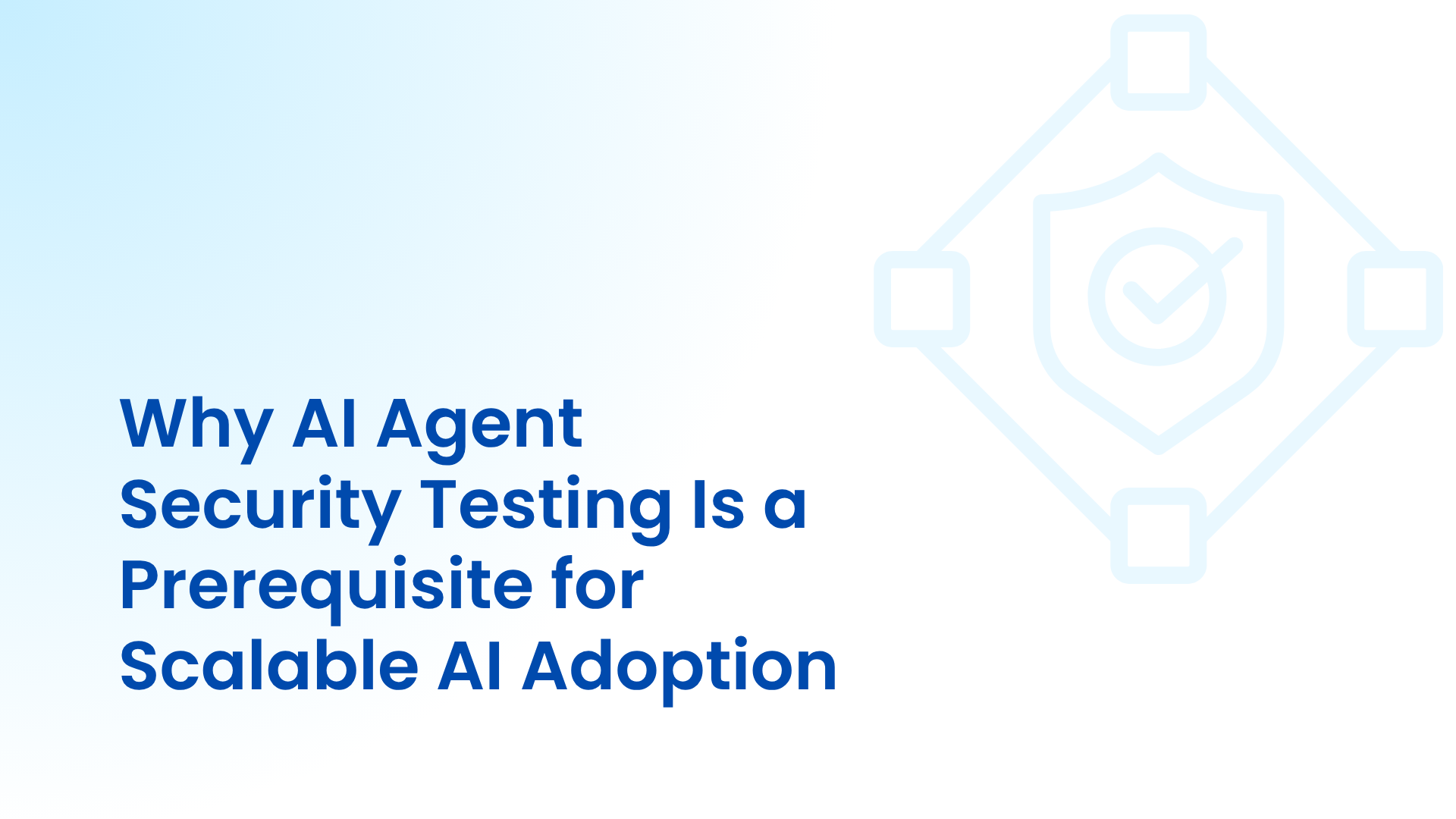Offensive security testing provides the trust layer needed for enterprises to move AI Agents from pilots to enterprise-wide adoption.
Today, 51% of organizations have already deployed agents, another 35% plan to within two years, and nearly 90% expect to run them in production by 2025. The motivation is clear: agents collapse cost and time by automating work that once depended on human effort.
Early adopters report 40–50% productivity gains in HR and IT, and JPMorgan has credited AI bots with saving 360,000 employee hours annually.
But the same autonomy that makes agents transformative also makes them untrustworthy without proof of control. Enterprises cannot hand over high-value tasks like processing financial approvals to handling regulated data, if they can’t test how agents behave before production.
In practice, this means manual teams stay in the loop for oversight and guardrails, eroding the very savings agents promise.
What should be a pathway to leaner, faster operations instead becomes a paradox: untested agents demand more human supervision, inflating costs and slowing adoption. The only way to preserve the efficiency gains is to establish trust up front and before agents are deployed in production through pre-production security testing.
Offensive security testing of AI agents is essential, not only because of the risks each agent carries on its own, but because those risks multiply when chained with MCPs, APIs, RAG pipelines, and LLMs at runtime.
Go through the blog to understand why Legacy security testing cannot keep pace and the approach needed for agents adoption at scale.
Why a Single Agent Can Be as Risky as an Entire System
A single agent can read sensitive data, make changes in production, or even trigger payments. That’s because unlike traditional systems, agents don’t just execute commands, they decide what those commands should be.
APIs carried out what they were explicitly told; agents interpret goals, plan actions, and choose their own paths across tools and systems.
Which is why to manage agent risk, you have to look closely at the pillars that underpin both their power and risk:
1. Every Capability Is Also an Attack Pathway
The capabilities of an agent define both its usefulness and its risk. A coding agent may execute scripts, a finance agent may trigger payments, or a support agent may update customer records. Each action pathway expands operational value, but also opens potential exploit paths. For agents, this means a corrupted input upstream (a poisoned retrieval snippet, a manipulated API response, or a hidden instruction in memory) can silently hijack its behavior. In this way, capabilities become vectors of compromise when unchecked.
2. Memory That Enables Productivity Can Also Leak Sensitive Data
Agents carry memory across sessions. That context may hold sensitive details or instructions that can be exploited later. A poisoned entry in memory isn’t obvious, but once recalled, it can steer the agent to leak data or perform unintended actions.
3. Permissions Remove Both: Human Bottlenecks & Safeguards
Agents operate under delegated tokens and workload identities. If scoped too broadly, they effectively become “machine admins.” A customer service agent with refund permissions doesn’t need to be directly hacked; if manipulated into misinterpreting an input, it can still process fraudulent transactions.
4. When Language Replaces Code as Inputs, Exploits Become Conversations
APIs once behaved like compilers: demanding rigid, structured inputs and rejecting anything out of bounds with clear errors. Agents, by contrast, behave more like interpreters: they accept unstructured, context-driven instructions in natural language. This flexibility is what makes them powerful, but it also broadens the attack surface as tricking the backends easier: attackers don’t need to exploit a bug, they can socially engineer the system through language.
The attack surface is no longer just code flaws; it’s also the language layer itself, where an adversary can trick an agent into bending or breaking rules.
When Agentic Risk Multiplies in Runtime Chains
AI agents don’t deliver value in isolation. Their true appeal is when they act in sync with the rest of the stack: orchestrating LLM calls, fetching context from RAG pipelines, invoking MCP tools, and pushing results through APIs. This interconnection collapses business friction, but it also multiplies security fragility. The risk is no longer about one agent misbehaving; it’s about how a single compromise ripples across every layer it touches.
Multi-Agent Workflows: From Collaboration to Cascading Failure
When agents collaborate, control becomes harder to trace and risks compound.
Opaque delegation means Agent A calls Agent B, which invokes C, yet most logs only capture the start and end. Attackers thrive in these blind spots, where a compromised middle agent can act invisibly.
Non-local effects occur when two “safe” agents produce a dangerous outcome in combination, one summarizing poisoned data, another approving a transaction based on it.
And because of the unbounded blast radius, a weak link chained to a high-privilege agent can turn a simple input into an admin-level action. Failures here don’t stay local; they fan out across the system.
What begins as collaboration for efficiency becomes a maze of invisible delegation and unpredictable side effects, the perfect conditions for attackers to hide, pivot, and escalate.
Why AI Agent Compromises Don’t Stay Contained & Cause System Compromise
The danger becomes clear when you trace a poisoned input through the runtime chain. A compromised agent may feed a malicious prompt into the LLM, steering it to reveal sensitive context. That poisoned instruction then flows into an MCP server, where static tokens or over-scoped privileges allow it to trigger downstream tools. As the agent enriches its plan with retrieval, the malicious snippet gets embedded in the vector database, contaminating future queries. Finally, APIs act on these corrupted outputs, auto-approving fraudulent loans, moving regulated data, or altering production systems.
What started as a single agent compromise doesn’t stay confined. It cascades across LLMs, MCP servers, RAG pipelines, and APIs, turning one weak point into an operational breach.
Why Legacy Security Testing Misses the Agentic Threat Surface
Legacy security testing was already insufficient for APIs. The shift to AI agents makes that gap catastrophic. These tools were designed for static applications with predictable inputs, fixed endpoints, and static UI.
Agents are the opposite: runtime-driven, adaptive, chaining across MCP servers, APIs, RAG pipelines, and LLMs. Testing them requires adversarial simulation of behavior, not code scans, endpoint payloads, or patchy monitoring.
1. SAST: Static Scans Cannot See Runtime Behavior
SAST only inspects the codebase, not what happens in execution. Most agent risks: privilege chaining, prompt injection, poisoned retrieval, lateral movement across MCP and APIs, manifest only at runtime. Looking at code alone cannot reveal how an agent behaves when chaining tools, making decisions dynamically, or carrying memory forward. Static analysis misses the attack surface completely.
2. DAST: Payloads Without Context Become Noise
DAST fires inputs at exposed endpoints but has no understanding of context or decision-making. AI agents do not expose clean, bounded endpoints. They operate through prompts, plans, and tool delegation. Without context, DAST produces floods of false positives and fails to capture the semantic attacks that exploit agent reasoning. For agents, this makes DAST not just incomplete but misleading.
3. IAST: Monitoring Without Testing Creates Blind Spots
IAST embeds sensors to watch behavior but does not actively probe or send payloads. At best, it offers partial visibility into a single application. Agents, however, run as meshes of orchestrators, LLMs, APIs, and MCP tools, often outside sensor coverage. Monitoring alone cannot surface vulnerabilities that emerge from cross-agent interaction or runtime chaining. Even the visibility it does provide is brittle, fragmented by placement, and blind to the seams where the real risks lie.
To truly scale AI, enterprises need pre-production offensive testing that validates how agents behave in runtime chains, not just how code looks in a repo or how an endpoint responds to a canned payload.
Legacy tools look at code in isolation or poke endpoints blindly. Levo starts where those approaches fail: full runtime visibility into how agents, LLMs, APIs, MCP servers, and RAG pipelines interact in production-like environments.
That visibility gives Levo the application context needed to generate adversarial payloads tailored to each agent’s role, permissions, and tool access.
By grounding testing in runtime and application context, Levo validates behavior before deployment so enterprises can prove security without relying on guesswork or static scans.
- Prompt Injection Testing validates how agents handle manipulated instructions, preventing semantic exploits that could redirect workflows or leak confidential data.
- Privilege Escalation Simulation ensures that permission chains cannot combine into “machine admin” capabilities, avoiding fraud, data tampering, or production outages.
- Sensitive Data Leakage Tests : Levo tests whether an AI agent mishandles private information in its responses, memory, or tool outputs. These tests ensure agents don’t become silent leakers of regulated data, protecting both compliance and trust.
- Rate Limiting Validation pushes agents and APIs beyond normal loads to ensure one poisoned or repeated request cannot escalate into bulk scraping or denial-of-service.
- Input Fuzzing uncovers brittle logic in how agents parse natural language, stopping malformed or adversarial prompts from triggering unintended system calls.
- Multi-Agent Workflow Simulation chains agents in adversarial test harnesses, surfacing emergent risks like toxic combinations of “safe” agents that traditional testing never sees.
Together, these tests let enterprises shift left with confidence: catching runtime exploits before agents hit production, and ensuring that every agent-powered workflow accelerates growth instead of derailing it.
Beyond AI Agent Security Testing , Complete AI Security
Levo extends beyond visibility to cover the full spectrum of AI security. Its breadth spans MCP servers, LLM applications, AI agents, and APIs, while its depth runs from shift-left capabilities like discovery and security testing to runtime functions such as monitoring, detection, and protection. By unifying these layers, Levo enables enterprises to scale AI safely, remain compliant, and deliver business value without delay.
Book a demo through this link to see it live in action!



.png)
.png)
.png)
.png)
